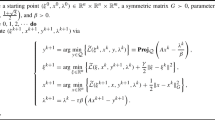Abstract
An interior proximal point algorithm for finding a solution of a linear program is presented. The distinguishing feature of this algorithm is the addition of a quadratic proximal term to the linear objective function. This perturbation has allowed us to obtain solutions with better feasibility. Implementation of this algorithm shows that the algorithms. We also establish global convergence and local linear convergence of the algorithm.
Similar content being viewed by others
References
Gill, P. E., Murray, W., Saunders, M. A., Tomlin, J. A., andWright, M. H.,On Projected Newton Barrier Methods for Linear Programming and an Equivalence to Karmarkar's Projective Method, Mathematical Programming, Vol. 36, pp. 183–209, 1986.
Karmarkar, N.,A New Polynomial-Time Algorithm for Linear Programming, Combinatorica, Vol. 4, pp. 373–395, 1984.
Rockafellar, R. T.,Monotone Operators and the Proximal Point Algorithm, SIAM Journal on Control and Optimization, Vol. 14, pp. 877–897, 1976.
McLinden, L.,An Analogue of Moreau's Proximation Theorem, with Application to the Nonlinear Complementarity Problem, Pacific Journal of Mathematics, Vol. 88, pp. 101–161, 1980.
Dennis, J. E., Jr., Morshedi, A. M., andTurner, K.,A Variable-Metric Variant of the Karmarkar Algorithm for Linear Programming, Mathematical Programming, Vol. 39, pp. 1–20, 1987.
Garcia Palomares, U. M., andMangasarian, O. L.,Superlinearly Convergent Quasi-Newton Algorithms for Nonlinearly Constrained Optimization Problems, Mathematical Programming, Vol. 11, pp. 1–13, 1976.
McCormick, G. P.,Nonlinear Programming, John Wiley and Sons, New York, New York, 1982.
Eisenstat, S. C., Gursky, M. C., Schultz, M. H., andSherman, A. H.,Yale Sparse Matrix Package, I: The Symmetric Codes, Yale University, Research Report 112, 1977.
Eisenstat, S. C., Gursky, M. C., Schultz, M. H., andSherman, A. H.,Yale Sparse Matrix Package, I: The Symmetric Codes, International Journal for Numerical Methods in Engineering, Vol. 18, pp. 1145–1151, 1982.
Gay, D. M.,Stopping Tests that Compute Optimal Solutions for Interior-Point Linear Programming Algorithms, Numerical Analysis Manuscript 89-11, AT&T Bell Laboratories, Holmdel, New Jersey, 1989.
Gay, D. M.,Electronic Mail Distribution of Linear Programming Test Problems, Mathematical Programming Society, COAL Newsletter, 1985.
Carolan, W. J., Hill, J. E., Kennington, J. L., Niemi, S., andWichman, S. J.,An Empirical Evaluation of the KORBX Algorithms for Military Airlift Applications, Technical Report 89-OR-06, Department of Computer Science and Engineering, Southern Methodist University, 1989.
Murtagh, B. A., andSaunders, M. A.,MINOS 5.0 User's Guide, Technical Report SOL 83-20, Stanford Optimization Laboratory, Stanford University, 1983.
Setiono, R.,Interior Least-Norm and Proximal Point Algorithms for Linear Programs, PhD Thesis, Computer Sciences Department, University of Wisconsin-Madison, 1990.
Author information
Authors and Affiliations
Additional information
Communicated by O. L. Mangasarian
This research was supported by National Science Foundation Grants DCR-85-21228 and CCR-87-23091 and by Air Force Office of Scientific Research Grants AFOSR-86-0172 and AFOSR-89-0410. It was conducted while the author was a Graduate Student at the Computer Sciences Department, University of Wisconsin, Madison, Wisconsin.
Rights and permissions
About this article
Cite this article
Setiono, R. Interior proximal point algorithm for linear programs. J Optim Theory Appl 74, 425–444 (1992). https://doi.org/10.1007/BF00940319
Issue Date:
DOI: https://doi.org/10.1007/BF00940319




